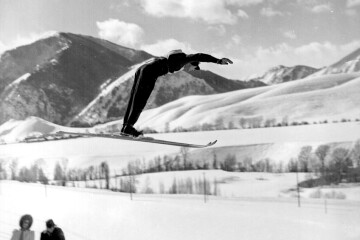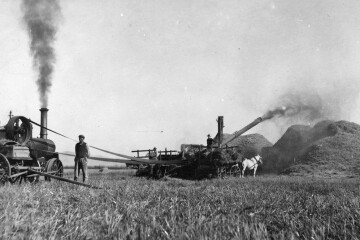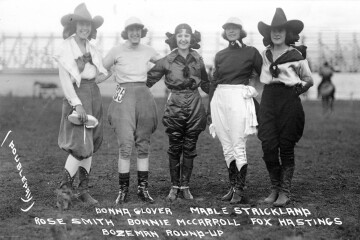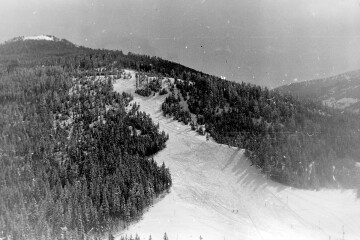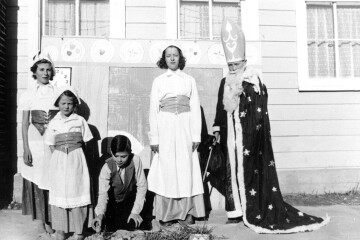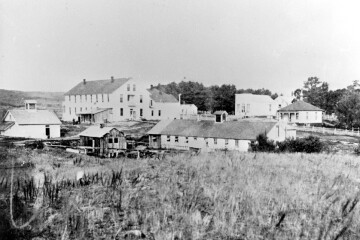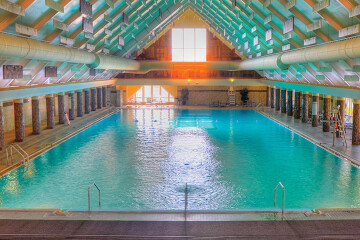Rainbow Land: A History of Bozeman Hot Springs
It’s summer—time for locals and tourists alike to cool off in ponds, lakes, rivers, and city pools. Today, families flock to water recreation areas like Hyalite and the Madison River, or visit in-town options like the Bozeman Swim Center, Bogert Pool, or Bozeman Hot Springs. Located just south of Four Corners, the popular resort at Bozeman Hot Springs boasts a long history in the Gallatin Valley.
Before the 1870s, the natural hot springs at the site were likely used by passing tribes and cattlemen during spring livestock roundups. The first commercial use of the area for health and recreation came in the mid-1870s when Francis Albert Lund marketed the springs as a cure for various ailments. F. A. Lund was a Swedish immigrant who came to Montana Territory during the gold rush, but it is unclear when he first acquired the hot springs property. According to an article in the Avant Courier newspaper in 1877, besides the beneficial properties of Lund’s Springs, “The ride from town is a very pleasant one, and the accommodations for parties are, we are assured, very good.” At a distance of about eight miles from Bozeman, a trip to the Lund Springs and back would have taken several days (including travel and relaxation time at the springs). Lund owned the hot springs for a few years before moving to California and then to Idaho, where he passed away in 1904.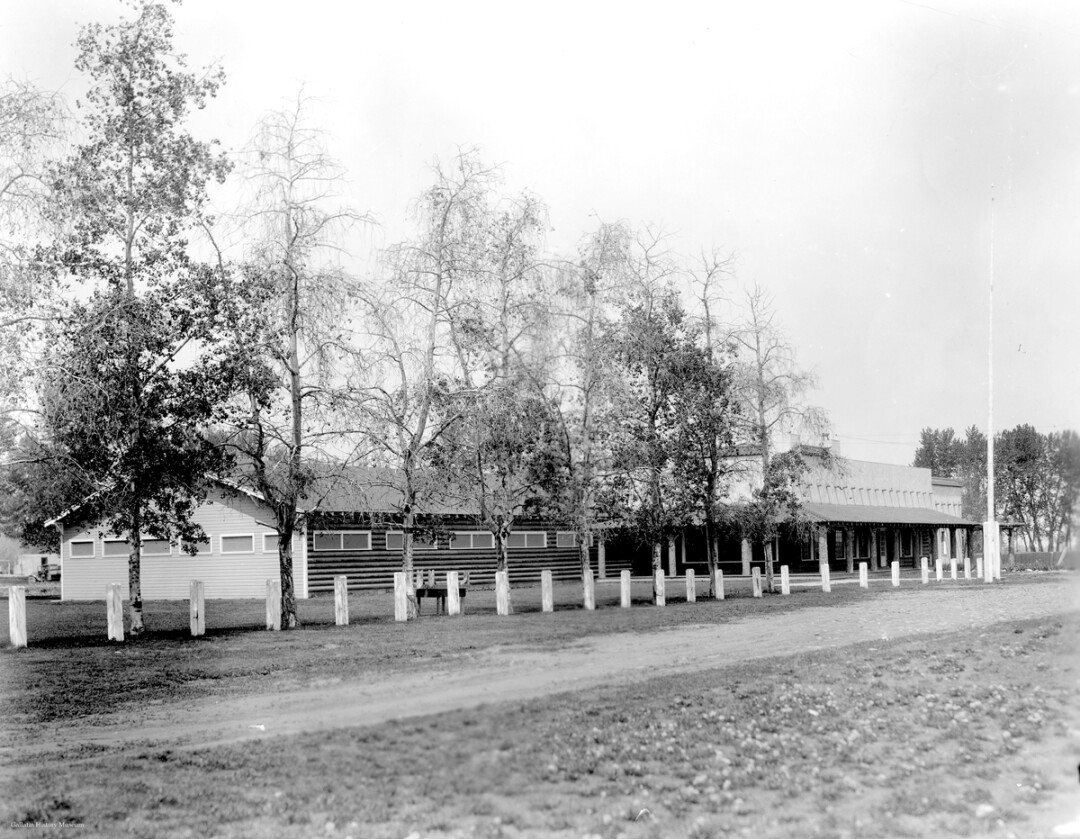
In 1879, Lund sold the hot springs to Jeremiah and Mary Matthews, who were both natives of Kentucky. Jeremiah was a carpenter by trade and had experience building wagons and carriages. These skills served him well at Matthew’s Hot Springs. Over the next ten years, the hot springs expanded to include a large bath house with dressing rooms and a swimming pool. The Avant Courier newspaper reported in October, 1879, that the water temperature of the pool could be adjusted hotter or colder, depending on a patron’s wishes. Eventually, Jeremiah’s health began to decline. The couple sold the hot springs and moved into Bozeman—to a house near the corner of South 3rd and West Curtiss Street. Jeremiah “Jerry” Matthews passed away in 1891.
When E. Myron Ferris purchased the property for $25,000 in 1890, it included hundreds of acres of surrounding farmland, a two-story residence, and a fourteen-foot by eighteen-foot plunge bath. Born in New York, E. Myron Ferris moved west as a young man and spent time in Wisconsin and Iowa. He married Fannie Allison in Sioux City, Iowa, in 1885, and the couple settled in Bozeman. Eddy Franklin Ferris, Myron’s brother, was already established in Bozeman as a banker, builder, and hardware dealer. Myron planned to run the hardware store but when the business fell through, his interests pivoted to the hot springs resort west of town.
In 1891, in order to attract tourists, Ferris constructed a large hotel which featured parlors, a large dining room, and plenty of porches and balconies for guests to relax outdoors. Elizabeth Purdum, one of E. Myron Ferris’s daughters, described the resort in an oral history interview in 1975:
“Well my father was ahead of his time and built a small, well you’d call it a motel now, but it was a two-story building. Oh, I think maybe we had 20 rooms and we would take people overnight or for meals and we had a Chinese cook…there was a plunge, a wooden plunge that was there when my father bought the place…and then there was another part of the bath house where there were a couple of wooden tubes, they were where hot water was piped in and people with rheumatism and things would come and bathe in the tubs. But the other end in the plunge—why that was recreational.”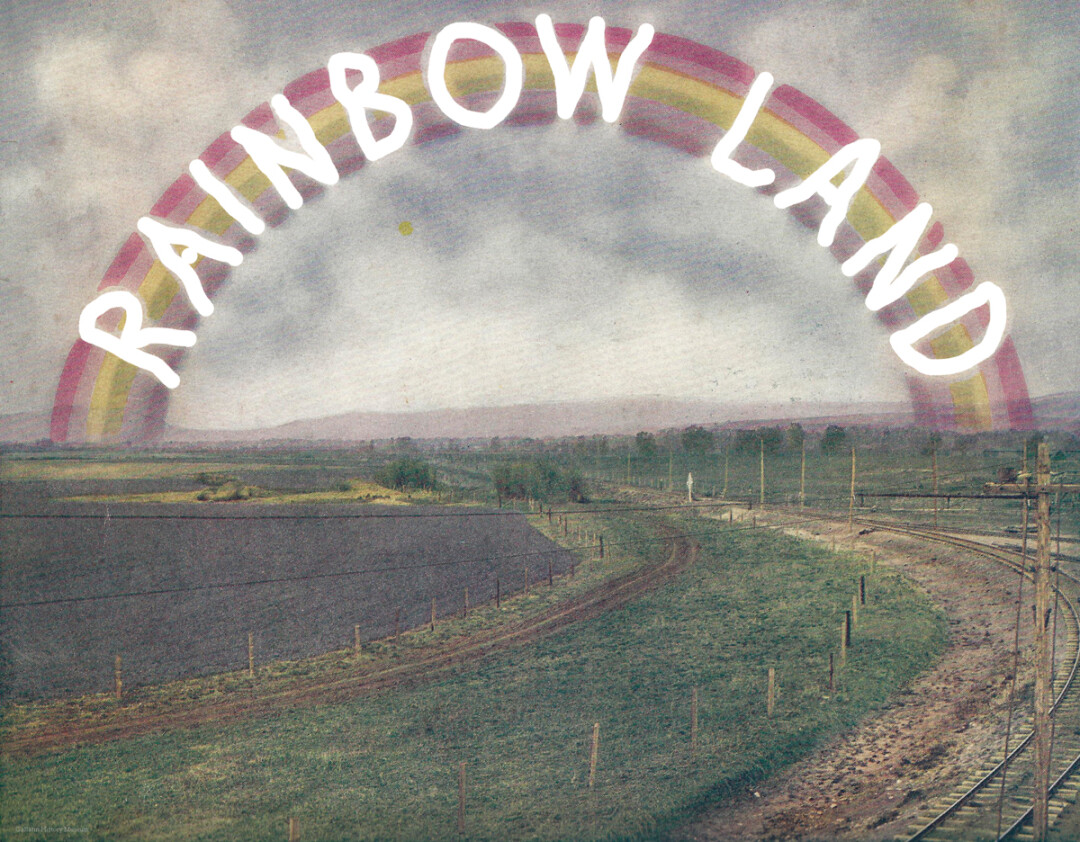
Unfortunately, travel to Ferris Hot Springs was still an issue, so Myron also operated a stage that transported guests between Bozeman and the resort. Streetcars had begun operation within Bozeman city limits in 1892, but more than fifteen years passed before a passenger rail system connected Bozeman with other communities in the Gallatin Valley. In 1909, the Gallatin Valley Electric Railway completed track for the interurban line, which provided passenger service from East Main Street in Bozeman to Salesville (Gallatin Gateway), Ferris Hot Springs, and beyond.
After owning the hot springs for nearly twenty years, E. M. Ferris decided to sell the property to the O. E. Meyers Realty Company. The plan was to parcel the property into lots of various sizes and sell them outright in a raffle for $150.00 each, or $10.00 per month after a $10.00 down payment. To add some excitement, one lucky buyer would receive a 10-acre parcel that included the hot springs and Ferris’s grand hotel. In order to push land sales in this early-day subdivision, the O. E. Meyers Realty Company produced a promotional booklet in 1911 titled Rainbow Land, which outlined the area’s many virtues. The name Rainbow Land likely originated from the abundance of rainbow trout in the nearby West Gallatin River, which was (and is) a popular fishing mecca for locals and tourists alike. In addition, the name undoubtedly was meant to conjure up images of a happy, idyllic lifestyle.
Of course, the most important feature of the proposed Rainbow Land was the hot springs. An analysis of the water conducted in the 1880s showed a mix of minerals, including silica, sodium silicate, calcium carbonate, magnesium carbonate, sodium carbonate, potassium chloride, sodium chloride, and sodium sulfate. The results of the analysis were good news. According to the promotional book, this beneficial ratio of minerals closely matched the mineral ratio found at Europe’s Carlsbad springs, a very popular destination resort. Rainbow Land boasted: “The experience of hundreds has proven that these waters are excellent remedial agents in cases of gout and rheumatism, and that kidney and liver and other troubles readily yield to their curative properties.” Another plus, according to the Rainbow Land book, was that the mineral water was so cleansing that no soap was needed. “On skin diseases their effect is magical, a short series of baths leaving the skin clear and white as alabaster.”
The grand prize winner of the parcel of land that included the hot springs and hotel was a Mr. Charles Greene from Fort Benton, who apparently ran out of money soon after acquiring the property. Ownership then passed to the Collett family. While reminiscing in 1975, Gerald Collett remembered hosting rodeos at the springs in the 1920s and 1930s—using a grandstand reconstructed from material taken from the old Bozeman Roundup stadium: “We opened on the same night that they had the Jack Dempsey-Tommy Gibbons fight up in Shelby; there were more people at the springs than at the fight in Shelby.” This claim could be a slight exaggeration, but there is no doubt that the resort was an active place under the Collett’s ownership. With the increase in automobile use in the 1910s and 1920s, families could more easily visit the hot springs. Day trips for picnics, swimming, and special events were common, and people viewed the hot springs more as a recreational destination than as a place to cure physical ailments.
The Collett family made several changes and additions to the resort. They moved the swimming pool, constructed a dance hall, and created a baseball field and rifle range. The dance hall burned down several years later but was rebuilt and used for decades. In the 1940s, it was repurposed, converted into a roller rink, and enjoyed anew by scores of children. Those who grew up in the Gallatin Valley will also remember the iconic, elevated bus at the resort’s entrance on US Highway 191, which, for years, served as a signal to impatient children that the fun was about to begin.
Bozeman Hot Springs has passed through several owners over the last seventy years, but continues to expand and delight visitors of all ages. The Avant Courier newspaper predicted in May, 1883, that “on its own intrinsic merits,” the hot springs would become a popular resort destination, “especially to the people of Bozeman and the Gallatin Valley.” It certainly has done just that.

